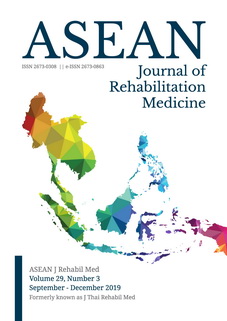Effects of Home-based Exercise Program Using Thai–style Braided Rubber Rope on Blood Pressure, Muscle Strength and Quality of Life in Patients on Continuous Ambulatory Peritoneal Dialysis
Keywords:
home-based exercise, blood pressure, muscle strength, quality of life, continuous ambulatory peritoneal dialysisAbstract
Objectives: A purpose of this study was to investigate effects of home-based exercise program using a Thai–style braided rubber rope on blood pressure (BP), muscle strength and quality of life of (QOL) in patients on continuous ambulatory peritoneal dialysis (CAPD).
Study design: A pretest-posttest design.
Setting: Department of Physical Medicine and Rehabilitation, Faculty of Medicine, Srinakharinwirot University.
Subjects: Thirty patients on CAPD.
Methods: After training and receiving a Thai–style braided rubber rope together with a brochure and an instructional rubber rope exercise video, all participants were asked to perform home-based exercise 3 times per week for 12 weeks. BP, hand compression and leg and back muscle force were assessed, and SF-36 health survey questionnaire was completed prior to the study as baseline and during follow-up visits at the end of 4th, 8th and 12th week of exercise. The baseline and the follow-up data were compared and analyzed with one-way ANOVA.
Results: There were 6 males and 14 females. Mean age was 51.6 years (SD 11.8) and mean duration of CAPD was 21.5 months (SD 19.1). When comparing data between the baseline and at the end of the 4th week, systolic and diastolic BP declined significantly (p < 0.05); hand, leg and back muscle strength increased; and the SF-36 scores of social functioning, bodily pain, emotional role functioning, and vitality, and the total score, increased significantly (p = 0.030, p = 0.009, p = 0.001, p = 0.000, p = 0.003, respectively).
Conclusion: After 4 weeks of home-based exercise with a Thai-style braided rubber rope, patients on CAPD had a decline in blood pressure, an increase in muscle strength, and a better quality of life especially vitality and emotion function
References
2. Kosmadakis GC, Bevington A, Smith AC, Clapp EL, Viana JL, Bishop NC, Feehally J. Physical exercise in patients with severe kidney disease. Nephron Clin Pract. 2010;115:7–16.
3. Luan X, Tian X, Zhang H, Huang R, Li N, Chen P. Exercise as a prescription for patients with various diseases. J Sport Health Sci. 2019;8:422-41.
4. Tawney KW, Tawney PJ, Kovach J: Disablement and rehabilitation in end-stage renal disease. Semin Dial. 2003;16:447–452.
5. Theofilou P. The role of sociodemographic factors in health-related quality of life of patients with end-stage renal disease. Int J Caring Sci. 2011;4:40-50.
6. Hart PD, Buck DJ. The effect of resistance training on health-related quality of life in older adults: Systematic review and meta-analysis. Health Promot Perspect. 2019;9:1–12.
7. Warburton DER, Nicol CW, Bredin SSD. Health benefits of physical activity: the evidence. Can Med Assoc J. 2006;174:801–9.
8. Seguin R, Nelson ME. The benefits of strengthen training for older adults. Am J Prev Med. 2003;25:141-9.
9. Asawakosinchai S, Sangpetch J, Rungsai W. Effects of health promotion with elastic band exercise on static balance and functional mobility in elderly people. J Prapokklao Hosp Clin Med Educat Center. 2011;28:110-24.
10. Krabuanpatana C. Yangyaedpichitrok. Department of Physical education, Faculty of Education, Kasetsart University [Internet]. [cited 2012 June 15]. Available from https://pr.ku.ac.th/pr_news/headnews/stick/Acrobat/p01.pdf
11. Leurmarnkul W, Meetam P. Development of a quality of life questionnaire: SF-36 (Thai Version). Thai J Pharm Sci. 2000; 2:92-111
12. Poomsalood S, Pakulanon S. Effects of elastic exercise program on balance in the elderly [Internet]. [cited 2012 June 15]. Available from https://researchconference.kps.ku.ac.th/article_9/pdf/p_sci_sport01.pdf.
13. Agarwal R, Flynn J, Pogue V, Rahman M, Reisin E, Weir MR. Assessment and management of hypertension in patients on dialysis. J Am Soc Nephrol. 2014;25:1630-46.
14. Paksa W. Effects of body weight and elastic trainings on elderly’s leg strength [Internet]. [cited 2012 June 15]. Available from https://thesis.swu.ac.th/swuthesis/Spo_Coa/Wilailak_P.pdf.
15. Kerbs DE, Jette AM, Assmann SF. Moderate exercise improves gait stability in disabled elders. Arch Phys Med Rehabil.1998;79:1489-95.
16. Beasley CR, Smith DA, Neale TJ. Exercise capacity in chronic renal failure patients managed by continuous ambulatory peritoneal dialysis. Aust N Z J Med.1986;16:5-10.
17. Lo CY, Li L, Lo WK, Chan ML, So E, Tang S, et al. Benefits of exercise training in patients on continuous ambulatory peritoneal dialysis. Am J Kidney Dis. 1998;32:1011-8.






